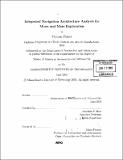Integrated navigation architecture analysis for Moon and Mars exploration
Author(s)
Chabot, Thomas
DownloadFull printable version (11.58Mb)
Other Contributors
Massachusetts Institute of Technology. Dept. of Aeronautics and Astronautics.
Advisor
Jonathan P. How.
Terms of use
Metadata
Show full item recordAbstract
The new solar system exploration objectives announced in January 2004 have the goal of sending humans back to the Moon by the year 2020 in preparation for human exploration of Mars. Advanced, but cost effective, surface navigation and communication capabilities are required to support these new exploration objectives. In response to this need, a set of three Navigation/Communication architectures have been designed: Minimalist, Simple, and Performance, as well as several augmentation options. The design and refinement of these architectures was performed using numerous models and tools developed for this work. A unique feature of the analysis in this thesis was that the architectures considered combine different navigation assets (onboard, on-surface and on-orbit). The three main Navigation/Communication architectures were then evaluated and compared using several metrics, such as navigation coverage, accuracy and operability, communication metrics, and mass. Based on this analysis we recommend the initial deployment of the Simple architecture for surface exploration of the Moon and Mars with a gradual accretion of assets and possibly transition to the Performance architecture. A specific combination of onboard and vision-based sensors is recommended as the fundamental navigation equipment. In addition to this navigation study, a control-based analysis of formation flying dynamic models around the libration point L₂ of the Sun-Earth system is also presented. The objective of this research was to assess the quality of different dynamical models of the relative motion of two spacecraft in orbit around Sun-Earth L₂. (cont.) This was done using open-loop simulations to investigate the intrinsic fidelity of each model and closed-loop simulations to evaluate the impact of modeling errors on fuel costs. The conclusion from this analysis is that the more sophisticated models give appreciable better closed-loop performance, and that the difference appears to be sufficient to justify the additional effort required to implement them on-line.
Description
Thesis (S.M.)--Massachusetts Institute of Technology, Dept. of Aeronautics and Astronautics, 2005. Includes bibliographical references (p. 127-131).
Date issued
2005Department
Massachusetts Institute of Technology. Department of Aeronautics and AstronauticsPublisher
Massachusetts Institute of Technology
Keywords
Aeronautics and Astronautics.